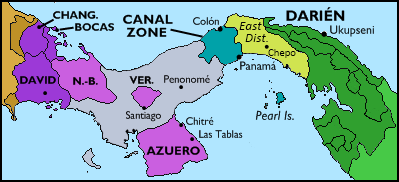False Dmitri (talk | contribs) mNo edit summary |
No edit summary |
||
| Line 9: | Line 9: | ||
Colombia also claims all of {{1983DD|Western Panama}}, which consists of a number of developed local statelets as well as smaller communities. Colombia's presence in the west is even less than in the east. |
Colombia also claims all of {{1983DD|Western Panama}}, which consists of a number of developed local statelets as well as smaller communities. Colombia's presence in the west is even less than in the east. |
||
| + | |||
| + | {{1983: Doomsday}} |
||
[[Category:Central American countries (1983: Doomsday)]] |
[[Category:Central American countries (1983: Doomsday)]] |
||
[[Category:Panama]] |
[[Category:Panama]] |
||
Revision as of 04:13, 18 February 2010

Current political map of Panama, with the East District shown in yellow.
The Distrito de Panamá del Este (District of East Panama) is a region of Panama lying between the Panama Canal Zone and the border of Colombia, specifically the Autonomous Region of Darién. Colombia claims this part of Panama. The South American Confederation and a number of other nations recognize this claim. In reality, most of the District is outside direct Colombian control. Though the District is small, it is volatile and dangerous.
Shortly after voting to annex the Darién in 1999, the Colombian Congress passed another act claiming all of the territory of Panama for Colombia. Panama had been a Colombian province until 1903 when it became an independent nation. The old province had been called "Istmo", but the act only used Panama's modern name. However, Colombia was unable to make good on its claim outside Darién. The East Panama District came into being late in 1999 by Act of Congress. It was to be the first step toward pacifying the region east of the Canal. A military expedition in 2000 ended in failure. During the 2000s Colombia tried several times to colonize the District, but was not able to extend its control past the defensive line of bases along Darién's border.
Recently Colombia has showed signs of a shift in its strategy. Using the Casa Verde Peace Agreement of 1986, which put an end to a number of violent rebellions in Colombia, as a model, the government has begun to negotiate with the warlords who control the region, and there has been talk about sharing power. However, the official Colombian stance is still that East Panama is its own territory.
Much of the military activity in the District remains a secret. Known Colombian/South American outposts include Portobelo on the Caribbean coast and a small base near Chepo in the interior. Chepo enjoys a road connection with Panama City; though the road is currently in ruin, it provides the town with an advantageous position, making it the most likely capital once Colombian rule is established. Currently, East Panama's military governor and his staff are based out of Panama City.
Colombia also claims all of Western Panama, which consists of a number of developed local statelets as well as smaller communities. Colombia's presence in the west is even less than in the east.
| ||||||||||||||||||||||

